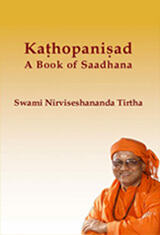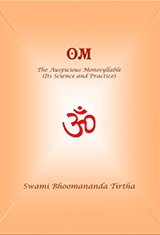Resources
19 | On Bhagavad Gita | Sthita-prajna and Sthita-dhee
Swami Bhoomananda Tirtha

The dream is inside the body. It is individualistic in nature. But wakefulness is a state, recurring regularly with many together remaining awake alike for 16 hours of the day, enabling interactions and their outcomes. This fact does not invalidate the truth that wakeful state totally rests upon the sleeper ‘I’. In understanding this fully and being enlightened about it, constitutes the mystery and majesty of the Sthitadhee, the man of stable intellect.
Dear and blessed souls:
Harih Om Tat Sat.
Having closely heard and followed what Krishna exposed, Arjuna asks a very significant question, lifting the dialogue to a very meaningful and elevated plane.
Arjuna’s question becomes deeper
18 verses that follow constitute a distinct section of the dialogue, popularly known as Sthita-prajñaprakaraṇa. It opens up a new section in the discussion of spirituality and its realization. When and how does one realize the Self, what succeeds such realization? Arjuna also has formed special phrases like Sthitaprajña and Sthita-dhee while making his enquiry. The verse 2.54 thus embodies the subjects of meditation, samadhi and post-samadhi spells.
Arjuna pointedly asks Krishna to describe the one seated in samadhi, whose consciousness has become steady and still. What and how will the Sthitaprajña, on waking from his samadhi, speak? How will he rest? How will he live and move interacting with the world, namely persons, places and events? What is the way by which he will remain, without losing touch with samadhi and how does he retain the benefits samadhi has bestowed on him?
Arjuna’s questions were four, but they cover the entire subject of spirituality, its pursuit, climax and fulfilment. Krishna also discusses where such fulfilment will lead the seeker and Knower to. The whole section is thus embedded with Brahmavidya sadhana and siddhi.
Enquiry on post-samadhi spell
When one is fully absorbed in the state of samadhi, he will not be able to speak or act. That is why Arjuna has worded his question as samadhisthasya sthitaprajñasya kā bhāsha – what is the description of the one seated in samadhi, whose consciousness is steady and still? He wants Krishna to explain the state of spiritual absorption which leads to Self-knowledge and realization.
Arjuna further enquires about the seeker who has woken up from samadhi with his new knowledge. Generally, during wakefulness, one is involved with the knowledge of objects the senses perceive. He has no knowledge of the Subject ‘I’, on which the entire object-knowledge is built and rests. In samadhi, when prajñā, consciousness becomes sthita, steady, no object-knowledge can prevail at all. There only the splendour and glory of the Self, the ‘I’, reigns. It is something distinct, singular and fulfilling.
Having gained such a subject-infusion, when one wakes up, he will certainly have a new knowledge treasure with him. It will be the guiding light for him in all he thinks, speaks and does. Arjuna wants to know the details about post-samadhi spell and the activity that transpires thereafter.
What or how will the Sthita-dhee speak? Note that this question is an aftermath of Arjuna’s insight into the Sthita-prajña and samadhi.
He also wants to know what will characterize the restful spell of the Sthita-dhee, within his wakeful state. Activity always drains the body. So, some rest is necessary for anyone in between. When the Sthitadhee rests thus, what will he think of or ruminate over?
What about the interactions he will have with the world and society? Will interactions secularize him or his samadhi experience will divinize everything he does? How does the Sthita-dhee preserve his enlightenment intact? Will not interactions with objects overwhelm his mind and eclipse his enlightenment and its sublimity?
See how well Arjuna has set his questions. Is it not clear that he had not only heard Krishna, but also had absorbed the message every time and purified his vision and assessments? This absorptional state and the subsequent follow up is what every seeker has to specially note and actualize himself.
Sthita-prajña and Sthita-dhee
Krishna begins to answer the questions in 18 verses, with which the second chapter named Sāṅkhya-yoga concludes. The entire portion is highly enlightening. It becomes a full treatise about Self-knowledge, how it displays itself, what are the benefits of Self-realization, what constitutes it, where should the seeker have his focus, etc. Krishna first describes Sthita-prajña and Sthita-dhee in very specific terms. Reading this portion thoroughly will make the seeker rightly focused. He will know what is real sadhana and how it bears fruit.
In verse 2.55, Krishna describes the Sthita-prajña, how does one become so: “When one completely relinquishes all desires, making the mind rest contented in his own Self, he becomes Sthita-prajña.”
Even when one seeks spirituality, he may have many fascinations, like becoming great, adorable to others, excelling in every way, so that the world will notice and regard him as a rare blessing. The world may look to him for advice and instruction. May be, he picks up yearning for gaining yogic powers – aṇimā (becoming minutely small), mahimā (becoming huge), laghimā (becoming light), gharimā (becoming heavy), etc.
Resting on the Self
True spirituality does not imply or necessitate any of these. The sole focus of the true seeker should be in the Self, the changeless ‘I’ in him. It is the inmost subtle spiritual presence which animates and activates the body. It is imperceptible to the senses. Nonetheless, it is fully experiential. Either to realize the Self or to preserve the realization, he needs nothing external or gross. So, the mind should be totally free and relaxed.
He should only strive, if at all, to rest on the Self. Where is the question of needing anything for this purpose?
So, drop everything and remain contented in your own inner Presence. One who does so, will inevitably be Self-absorbed. In such a state of absorption, there will be no movement or vibration at all. One in such a state is called Sthita-prajña. A Sthita-prajna effortlessly remains restful in himself, contented to the core. It is an easy, natural, complete state of inner abidance.
There is nothing more to say about the Sthitaprajñatā. Having completed this definition of Sthitaprajña, Krishna proceeds to answer the next questions on Sthita-dhee.
Making the intelligence steady and stable
Verse 2.56 describes the Sthita-dhee. Sthita-dhee is one who has awakened from Sthita-prajñatā. Just as everyone who sleeps gets up after a time, the one absorbed in samadhi will also have to wake up from it. Consequently, he has also to interact with persons, places and events. Will his interactions be the same as before? Or will the Sthita-prajñatā he has experienced exercise its influence and sublimity in his mind and intelligence? The question is very relevant.
The word Sthita-dhee is especially significant in this context. It is quite suggestive. If during samadhi the prajñā, consciousness, becomes steady and still, in the post-samadhi period it is the intelligence that becomes steady and stable. The difference should be grasped in all its emphasis. It is the mind that employs the senses and interacts with the objects around.
All the consequent mental imprints are to be studied by the intelligence, then compared, contrasted and evaluated, and the resultant benefit should be infused into the mind. Only then the mind will be able to remain peaceful and yet functional in its role of activating the senses during interactions. Hence the steadiness in the post-samadhi spell is to the intelligence. Dhee means intelligence, thus the word sthita-dhee to describe one awakened from steadiness and stillness of samadhi, is quite apt and meaningful!
Harmonizing interactional impacts
Krishna says the Sthita-dhee has his distinct attitude and sublimity in facing life and pursuing interactions. All interactions are bound to bring about sukhaduḥkha-dvandvas, which are the net outcome of all dvandvas constituting the world and our life. Duḥkha is always unpleasant, tormenting. But the Sthitadhee will not have any torment worth mentioning. He will, no doubt, not invite any duḥkha. But whenever duḥkhas arrive, he will not resent or revolt. He will accept the plight as natural and inevitable to interactions.
Likewise, when sukhas encounter him, he will have no lingering delight or interest in them. Like duḥkha, sukha also comes only to go. Both are equally transitory. This spiritual insight, with consequent stability, will shine, overwhelming the usual impact of both. The subject ‘I’ is always superior to transitory objects. All the objects are but inner imprints surfacing in the mind.
Thus, every interaction together with its impacts is harmonized by the Sthita-dhee’s mind. If at all, the impacts every time only strengthen his stability and poise. So, in a way, the interactions and their impacts have always a strong promotional effect.
Transcending attraction, repulsion and fear
Krishna adds that one becomes a Sthita-dhee when he transcends desire (rāga), repulsion (dvesha) and fear (bhaya). Attraction, repulsion and fear are the three strands by which the mind-rope is made. Sthitadhee is graced so much that the changeless substratum called the Self that he is, is not pressurized by the rāgadvesha-bhaya triplet. He is easily able to swim in the waters of rāga-dvesha-bhaya.
Human mind is a treasure. It has tremendous potential, depth, vastness and resourcefulness. Mind can assimilate all kinds of impacts. Every impact is actually mind’s own response and reaction to the interactional outcome. It is like the waves on the sea.
No wave disturbs or overwhelms the sea. Even more so is the case with the mind-sea. No emotion in the form of attraction, repulsion or fear will be able to unsettle or overwhelm the mind.
In Sthita-prajñatā, the Knower has already experienced the extremely subtle and blissful nature of the Self, Consciousness. In that light, interactions only reinforce the Sthitadhee, by sublimating their impacts and enriching his mind and intelligence with greater stability and poise every time. Sthita-dhee hence becomes stability and harmony personified. Whatever he thinks, speaks and does, his contemplation is naturally established in the ever-sparkling Self. Everything is its expression, manifestation and extension. It is like strings of waves, breakers, ebbs and tides surfacing on the huge sea. The process becomes more a confirmation and revelation of sea’s vastness than any conflict or contradiction.
An epithet of uniformness and homogeneity
Muni, manana-śīlaḥ, is one given to reflecting on the inmost singular Consciousness, its majesty and magnificence. He is equally a lover of silence, whose ultimately pure form is Nirvikalpa Samadhi. The Sthita-dhee has no rise or fall. He undergoes no transformation. Like the Self which is ever the same with its un-tarnishable splendour, he also remains in his own depth and fullness of inner spiritual vision. With no place for any desire and fear towards anything or anyone, the Sthita-dhee shines as an epithet of uniformness and homogeneity, characteristic of the supreme Reality, the Self.
It is only in this verse Krishna uses the word Sthitadhee. Arjuna’s question was what and how would Sthita-dhee speak? Sthita-dhee will have nothing but the glory, greatness and splendour of the Self, the absolute presence on which the endless and varietal creation manifests, to feel and speak about. Like all others, he may see with his eyes in the body, hear with ears, smell with nose, taste with tongue and touch with skin. His mind consequently will also build inner imprints of these sense contacts. His intelligence may equally rationalize the data fetched by the mind and many a note gathered by intelligence. Such knowledge and vision, of course, would repeatedly emerge. But none of these processes is capable of causing the least transformation or division in him, in the Consciousness that displays all these.
‘I’, the singular sleeper
The process implies a great deal more. The nature and display of the ineffable Consciousness is to give rise to change, addition or multiplication. In fact, the entire world is verily an outcome and display of the wakeful state, which emerges from deep sleep, from the ‘I’, the singular sleeper. The truth is evidenced again and again by the fact that every day, wakefulness leads to and ends in deep sleep for half the wakeful duration. Can it then be anything besides the sleeping ‘I’, which displays, like dream, what the sleeper is and has?
The dream is inside the body. It is individualistic in nature. But wakefulness is a state, recurring regularly with many together remaining awake alike for 16 hours of the day, enabling interactions and their outcomes. This fact does not invalidate the truth that wakeful state totally rests upon the sleeper ‘I’. In understanding this fully and being enlightened about it, constitutes the mystery and majesty of the Sthitadhee, the man of stable intellect.

“Having gained such a subject-infusion, when one wakes up, he will certainly have a new knowledge treasure with him. It will be the guiding light for him in all he thinks, speaks and does. ”
“When one completely relinquishes all desires, making the mind rest contented in his own Self, he becomes Sthita-prajña.”
“The sole focus of the true seeker should be in the Self, the changeless ‘I’ in him. It is the inmost subtle spiritual presence which animates and activates the body. It is imperceptible to the senses. Nonetheless, it is fully experiential. ”
“If during samadhi the prajñā, consciousness, becomes steady and still, in the post-samadhi period it is the intelligence that becomes steady and stable. The difference should be grasped in all its emphasis.”
“Every interaction together with its impacts is harmonized by the Sthita-dhee’s mind. If at all, the impacts every time only strengthen his stability and poise. So, in a way, the interactions and their impacts have always a strong promotional effect.”
“No wave disturbs or overwhelms the sea. Even more so is the case with the mind-sea. No emotion in the form of attraction, repulsion or fear will be able to unsettle or overwhelm the mind. ”
you might be interested in

Swami Nirviseshananda Tirtha
09 – Bhagavad Gita – Chapter 18 – by Swami Nirviseshananda Tirtha – Way to Freedom

 515 views
515 views

 Add to Favorites
Add to Favorites Add to Reading List
Add to Reading List








